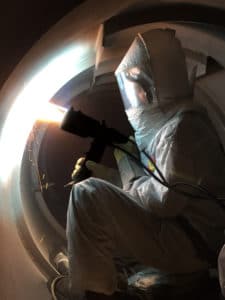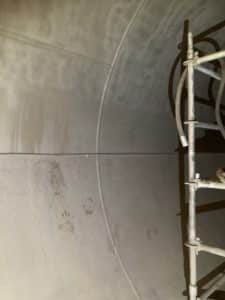How to Prevent Corrosion Caused by Renewables Conversion

Many oil and gas companies are repurposing refineries to produce renewable diesel, sustainable aviation fuel, and other renewable biofuels and products. The replacement of fossil fuels will help to decrease greenhouse gas (GHG) and CO2 emissions.
To incentivize the production of renewable fuels, the US Environmental Protection Agency’s Renewable Fuel Standard (RFS) Program requires that 36 billion gallons of renewable fuel replace or reduce the quantity of petroleum-based transportation fuel, jet fuel or heating oil by 2022.
Process equipment designed to refine crude oil products will now be faced with new chemical compositions, pressures, and temperatures. This new processing environment leads to new corrosion mechanisms which can all detrimentally affect existing carbon steel, stainless steel or internally clad reactors, drums, and other process equipment.
New Corrosion Mechanisms
Corrosion mechanisms in renewable diesel processing are unique. Conventional base materials of columns, towers, and reactors, as well as past corrosion mitigation strategies, are unsuitable in these new operating environments.
The processing of renewables means that reactors become susceptible to high temperature free fatty acid (FFA) corrosion, sulfidation, wet chloride corrosion, and stress corrosion cracking.
To protect these materials, a metallurgy upgrade is required to avoid corrosion and potential asset failure. There are several options available to achieve this.
The Solutions
Weld Metal Overlay (WMO)
Welding is a commonly used solution in the wider oil and gas industry, both for rebuilding degraded areas of wall thickness and for providing a corrosion-resistant alloy barrier.
However, welding carries some fundamental drawbacks. A common issue is the distortion of the shell due to heat input during the welding process, which can further require crane support for the equipment. A high degree of stress gets added during welding, especially on thinner wall vessels. Additionally, the weld procedure, code, or environmental conditions may require heat treatment prior to or after the application as an additional step to the repair solution.
There is also a question of time and costs. Welding is a relatively slow process with an application time of 10 – 16 ft2 (1 – 1.5m2) per weld head per shift and can cause additional delays in bringing the asset back into service. Depending on the time frame available for converting to renewables, using the method of welding for corrosion protection can have a significant financial impact.
High Velocity Thermal Spray (HVTS)
At IGS, we have developed a proprietary solution: HVTS. It is designed to protect the base metal in high corrosion environments and involves the simple application of a non-porous high nobility metal alloy. This application upgrades the metallurgy of base materials, protecting them from new operating environments.
The application process is considerably faster than welding and there are no stresses imposed on the base material during the application process. Furthermore, the HVTS process does not generate any dilution and the cladding remains uncompromised meaning there is no potential for galvanic corrosion due to dissimilar metals.
HVTS Features:
| Application Speed | 32-64 ft² / 3-6m² per shift per HVTS machine |
| Heat treatment before/after application | Not required, no pre-heat or HAZ |
| Bond: | Mechanical and Chemical (>35 MPa) |
| Thermal resistance | Over 1000°F / 537°C |
Top Tips for Upgrading Metallurgy for Renewables Conversion
Prequalifying the Solution
When selecting a contractor to protect mission-critical equipment from new processing environments, there are several things to consider. Firstly, the contractor should work with the EPC, asset owner and the licensor to deliver a comprehensive pre-qualification process to govern the quality of the applied surface technology solution and ensure that the protection solution is suitable for the new harsh corrosion mechanisms. Rigorous tests should be performed by the provider in advance of the application.
Delivering a Technical Package
A good surface solutions provider should deliver a complete technical package of services ensuring a turnkey site application within agreed timescales, including:
- Project Plan
- Method Statement
- Project Safety Analysis
- Risk Assessment and Mitigation Plan
- Job Specific Safety Data Sheets
- Material Selection
- Surface Preparation
- Utilization of the Application Process
- Critical QA/QC Controls
- Post Project Reports
Case Study: 50% Savings in Renewables Conversion achieved at a plant in Eastern Canada
The former refinery in Eastern Canada was performing a site-wide conversion in preparation for firing renewable fuels instead of oil. The Canadian government was partly financing the conversion. The refinery will start processing sustainable aviation fuel (SAF) in Summer 2022. Using SAF results in an up to 80% reduction in carbon emissions compared to the traditional jet fuel it replaces over the lifecycle of the fuel.
The Problem
Two reactors and two drums required a metallurgy upgrade due to new operating conditions. With renewables processing, reactors are susceptible to high temperature free fatty acid (FFA) corrosion, sulfidation, wet chloride corrosion, and stress corrosion cracking.
The drums had possible damage mechanisms including wet CO2 corrosion, wet chlorides and potential NH4HS and NH4CL.
The Solution


The refinery, in conjunction with its EPC, elected to go with the Integrated Global Services (IGS) HVTS solution.
Jason Lynn, IGS HVTS SME, said: “I would say that they probably saved half of their cost compared to automated welding. In terms of time, they saved a third of their time, so that was important.”
“Another reason why they didn’t choose automated welding, was the fact that it would require preheat, which again would take more time and resources. This was an important factor as the facility is in Arctic conditions.”
“The facility appreciated the fact that IGS could work turnkey. They didn’t want to have multiple vendors performing different tasks with one group doing preheating, another group welding with a third group potentially doing the post-weld heat treatment.”
Furthermore, much higher deposition rates, without dilution or needed “butter” / intermediate layers to achieve surface chemistry, made HVTS the solution of choice for this application.”
Material Science
Two different alloys were designed and specified for the drums and the reactors. NiCroMoXX type material was specified for the reactors due to its excellent resistance to chloride corrosion, SCC and sulfidation. For the drums, a NiCroMoWXX material was specified for its proven corrosion and erosion resistance.
Prequalifying the Solution
The EPC, asset owner and the licensor required a comprehensive pre-qualification and adherence to a tight engineering standard to govern the quality of the cladding applied and ensure that the HVTS protection would hold up against the new harsh corrosion mechanisms. Tests were performed in the IGS laboratory in Richmond, Virginia to alleviate any concerns.
Iain Hall, IGS CTO, said: “While material selection is important, it is only a small part of the technical package required to ensure durable long-term performance in claddings systems. Careful attention to surface preparation and accessibility, utilization of High Velocity process and critical parameter control is necessary to ensure homogenous alloy cladding with the right mechanical properties. It also takes more than a coupon to qualify an application. Management of environmental conditions and monitoring of field quality control with real-time production test plate assessments is also required.”
Project Execution
The engineering package was successfully delivered, including the project plan, method statement, inspection test plan, project safety analysis, risk mitigation plan and the job-specific safety data sheets. The whole project was completed in 29 days.
Summary
With the rise in renewables conversion, there is a multitude of issues to consider for oil and gas companies. Corrosion protection is critical for long-term asset performance and a comprehensive mitigation strategy should be in place at the beginning of the conversion process.
A preventative maintenance plan will ensure that asset life is prolonged, the risk of costly unplanned outages is reduced, and performance and efficiency are maximized.
